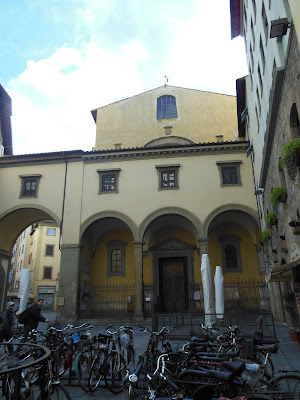 |
| Vasari Corridor in front of the church's facade. |
Inside the church, Professor Looney mainly spoke about Pontormo's The Deposition from the Cross; although painted during the High Renaissance period, it's style is incredibly different from that of earlier paintings, often cited as an example of mannerism. Pontormo focused on color rather than mass and also omitted including the cross, but did include a self-portrait in the background!
We walked to Palazzo Pitti and Professor Looney pointed out the apartment where he stayed the first time he studied in Italy... right across from Palazzo Pitti! It was really fantastic to hear about his experiences studying abroad and even more interesting to hear that a famous Italian writer, named Umberto Saba, lived in his room before him!
Because people are only allowed to enter Santo Spirito church until 12:30 on Saturdays, we hurried over to the church which is seemingly simple from the outside, but very beautiful inside, and is one of the greatest examples of Renaissance architecture. Brunelleschi designed the outlay of the church and its 38 chapels, but not the baldachin over the high altar which was added in 1601. Each chapel of the Basilica was paid for by an important family of Florence, and many of the paintings include portraits of the patrons.
Our final stop on the Oltrarno tour was the church of Santa Maria del Carmine, mainly to look at the Branacci chapel which was the only thing left untouched by a fire that burned down most of the original church in 1771 and which holds important frescoes by Masolino, Masaccio, and Lippi. Although the rebuilt church is built in a rococo style (late Baroque), the chapel's frescoes are of the Renaissance and most particularly mark the transition into Renaissance. Masolino was a Gothic painter who worked with Masaccio as his assistant and their contrasting styles can very clearly be identified; while Masolino's figures were still flat, somewhat lifeless, Masaccio's figures had volume. Their painting styles differed in that Masolino focused on line, while Masaccio focused on mass.
 |
| Masaccio's The Tribute Money on top, Lippi's Raising of the Son of Theophilus and St Peter Enthroned on bottom |
 |
| Pitt's very own Professor Looney |


No comments:
Post a Comment